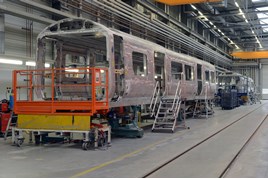He says the pre-assemble to delivery is 14 days for an entire train. When the “big ramp-up” (as Smith calls it) begins in September, two vehicles per day will be constructed. That will then rise to three, with one destined for SWT. “I have capacity for 60 bodyshells per month, and I have five production lines,” says Esslimani.
On the day of RAIL’s visit to Krefeld, four vehicles from 700107 were being shunted prior to delivery to Wildenrath, while an eight-car train was being constructed.
This is the 13th train to be built, and will be the second eight-car delivered (making it probably 700002). Esslimani says that it will be at Wildenrath as a complete train by the end of May. Currently there are 20 people working on it, but when the production line is in full swing he says that 60 to 70 staff will be working, with a further 10 electricians. When the SWT work is added, that will grow by another 20 staff.
At Wildenrath, there are 30 kilometres (nearly 19 miles) of track. Constructed in 1950, the former RAF airfield was part of the nuclear strike force, and in the 1970s it was home to Harrier jets. The runway is still visible. Following the end of the Cold War, it closed on April 1 1992. Siemens bought it five years later.
It has a public rail company for cargo transport, which means that trains can be delivered by rail from Krefeld. It is also connected to the former Iron Rhine - a partially non-operational freight railway that connects Antwerp in Belgium with Monchengladbach in Germany. Plans for its full re-opening have stalled owing to (among other reasons) concerns from local residents regarding noise. It seems this subject is not confined to the UK!
Oliver Hagemann, head of test and validation centre for Siemens AG, says: “We are not Siemens only. We can, and do, allow other manufacturers on site. We are proud of that independence.”
Wildenrath has five tracks on which various tests are carried out (the ‘700s’ are using T1, a 6km oval test track at speeds up to 100mph). Hagemann says that the first infrastructure change at the site was the installation of UK overhead line equipment (OLE) in 1999. “Now we change every few years,” he adds.
There are different gauges and different facilities at the site, all for testing various trains. Hagemann says major operators, universities and court investigations use Wildenrath.
“We can simulate border controls for ETCS . There is a workshop service, too. They do work refurbishing rail life support and crash accident repair. We will probably be the maintenance hub for a new German contract. The main depot for that will be in Dortmund.”
Daragh Lowry, Class 700 Thameslink trains customer director, Siemens AG, says: “We have installed AC/DC power on T1 and the power change can be done on the move using belises, although that will not happen on the route. ATO is installed, and we have effectively re-created the Core.”
Govia Thameslink Railway Chief Executive Charles Horton, speaking at Krefeld on April 2, said of the trains: “We have to get the balance right. You cannot please all the people all of the time. I think the trains do a good job of balancing the needs of long-distance and commuter. If we achieve the possibility of everyone is satisfied, then I will be happy.”
Out on the train, I am lucky enough to sample nine loops of T1, driving one trip at up to 77mph. The train (700101) is a smooth ride. Its acceleration is impressive, as is its braking.
Classmates 700103/105/106 are inside a testing shed having been used for commissioning, with 700103 fitted with internal decals. Outside the shed is 700102, while 700104 is formed as an eight-car train. One of the trips witnesses the arrival of four vehicles from 700107.
As I walk around the centre, 700101 can again be glimpsed racing between the trees. Soon, the ‘700’ will be glimpsed racing along GTR routes. It’s taken a long time to get to this stage - just another stage on the long Thameslink journey.
- This feature was published in RAIL 772 on April 15 2015
















Login to comment
Comments
No comments have been made yet.